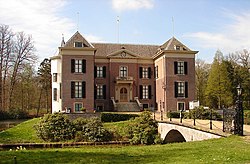Huis Doorn

Huis Doorn in 2010
|
|
|
Location of the museum in Utrecht in the Netherlands
|
|
| Established | 1956 |
|---|---|
| Location | Langbroekerweg 10 Doorn, Netherlands |
| Coordinates | 52°01′53″N 5°20′19″E / 52.0314°N 5.3386°ECoordinates: 52°01′53″N 5°20′19″E / 52.0314°N 5.3386°E |
| Type |
National museum Historic house museum |
| Visitors | 25,000 (2012) |
| Director | F.M. Louhenapessy |
| President | R.C. Robbertsen |
| Website | www |
Huis Doorn (Dutch pronunciation: [ɦœyz doːrn]; English: Doorn Manor) is a manor house and national museum in the town of Doorn in the Netherlands. The museum shows the early 20th-century interior from the time when former German Emperor Wilhelm II lived in the house.
Huis Doorn was first built in the 9th century. It was rebuilt in the 14th century, after it was destroyed. It was again rebuilt in the 19th century to its present-day form. The gardens were also created in the 19th century. After World War I, Wilhelm II bought the house, where he lived in exile from 1920 until his death in 1941. He is buried in a mausoleum in the gardens. After the German occupation in World War II, the house was seized by the Dutch government as hostile property.
Huis Doorn is now a national museum and a national heritage site. The interior of the house has not been changed since Wilhelm II died. Every year in June, German monarchists come to Doorn to pay their respects to the emperor. In 2012, the museum had 25,000 visitors.
The first house was built in the 9th century, but it was destroyed and rebuilt in the 14th century. It was again rebuilt in the late 18th century in a conservative manner and, in the mid-19th century, a surrounding park was laid out as an English landscape garden.
Baroness Ella van Heemstra (1900–1984), the mother of actress Audrey Hepburn, spent much of her childhood living in the house.
The property was purchased in 1919 by Wilhelm II, the last German Emperor, as his residence-in-exile (1920–1941), following his abdication after World War I. During his years in exile, he was allowed to travel freely within a 15-mile radius of his house, but journeys farther than that meant that advance notice had to be given to a local government official. As he disliked having to kowtow to a minor official, he rarely journeyed beyond the "free" limit. The former Emperor regularly exercised by chopping down many of the estate's trees, splitting the logs into stacks of firewood, thereby denuding the matured landscape as the years progressed. Hence he was called by his enemies "The Woodchopper of Doorn".
...
Wikipedia

